How To Run Sphinx Validator Shardeum Blockchain Network ?
Benifits of operating a validater a node ?Running your own validator Here -enhances Shardeum network security -earns testnet SHM from user transaction fees
Minimum Hardware Requirement
-250 GB SSD storage
-Quad core CPU less than 10 years old if self hosting -Dual core CPU works if hosted with newer Xeons / EPYC -16 GB of ram, 4+ GB of virtual memory recommended -Hosting: 8 GB RAM + 8 GB Virtual Memory
How Do I Run a Vallidater Node On Shardeum ?
- Step 1 : Install prerequisites - Open a Shell terminal on your pc or laptop
- Access the terminal interface for Shell CLI commands:- For Linux and Ubantu Os System Follow All Step -
- Now Follow All Command Carefully Guys -
-- Run : Command 1 - sudo apt-get install curlUpdate package managers Make sure your packages are up to date first:- Install docker Install docker with docker.io:
Run: -- Command 2 - sudo apt install docker.ioCheck that docker is working with (should return version 20.10.12 or higher):**Shell Run: **-- Command 3 - docker --version
Install docker-compose
Run: **-- Command 4 - sudo curl -L "https://github.com/docker/compose/releases/download/1.29.2/docker-compose-$(uname -s)-$(uname -m)" -o /usr/local/bin/docker-compose
Run: -- Command 5 - sudo chmod +x /usr/local/bin/docker-compose
Check that docker-compose is working with (should return version 1.29.2 or higher):
Run: -- Command 6 - docker-compose --version
-- TIP - #Shardeum Validator support on Windows will be coming in the future.
Step 2 : Download and install validator
**Run: **-- Command 7 - curl -O https://gitlab.com/shardeum/validator/dashboard/-/raw/main/installer.sh && chmod +x installer.sh && ./installer.sh
The terminal will ask questions about your setup settings.
Give permission to collect validator data for bug reporting:
By running this installer, you agree to allow the Shardeum team to collect this data. (y/n) ?
Enter y to setup the web based dashboard:
Do you want to run the web based Dashboard? (y/n) ?
**- Set a password for dashboard access: **Set the password to access the Dashboard:
**- Add a custom session port for the web based dashboard or hit enter for port 8080:**Enter the port (1025-65536) to access the web based Dashboard (default 8080):
**- Add a custom external IP address or use an automatically detected IP address:**If you wish to set an explicit external IP, enter an IPv4 address (default=auto):- **Add a custom internal IP address or use an automatically detected IP address:**If you wish to set an explicit internal IP, enter an IPv4 address (default=auto):
**- Set the first p2p port (default 9001):**To run a validator on the Sphinx Validator 1.X network, you will need to open two ports in your firewall. This allows p2p communication between nodes. Enter the first port (1025-65536) for p2p communication (default 9001):- **Set the second p2p port (default 10001):**Enter the second port (1025-65536) for p2p communication (default 10001):
- Add a custom path or install to root:
What base directory should the node use (defaults to ~/.shardeum):
Wait for the installation process to complete.
Step 3: Open validator CLI
Make sure you are in the root directory by running:
Comand - 1 - cd
**Go to the hidden Shardeum directory:
Comand - 2 **- cd .shardeum
**Start the CLI by running the following shell script:
Comand - 3 **- ./shell.sh
WARNING
If you see docker container error:
Error response from daemon: Container <container_id_hexadecimal> is not running
**start all docker containers until the errors go away:
Comand - 4 **- docker start <container_id_hexadecimal>
WARNING
If you see docker permission error:
Got permission denied while trying to connect to the Docker daemon socket at unix:///var/run/docker.sock: Get "http://%2Fvar%2Frun%2Fdocker.sock/v1.24/containers/shardeum-dashboard/json": dial unix /var/run/docker.sock: connect: permission denied
**Run:
Comand - 5 **- sudo usermod -a -G docker $USER && newgrp docker
**if that does not work, also try:
- Comand - **sudo service docker start
Then try to start the shell script again.
Step 4: Open validator GUI
While inside the shell script, run:
- Comand 1 - operator-cli gui start
- Go to your web browser and go to : https://localhost:8080/
CAUTION
You might see a warning page when trying to access this address in your web browser. Ignore this warning and continue to the validator dashboard. Another way to work around this warning:
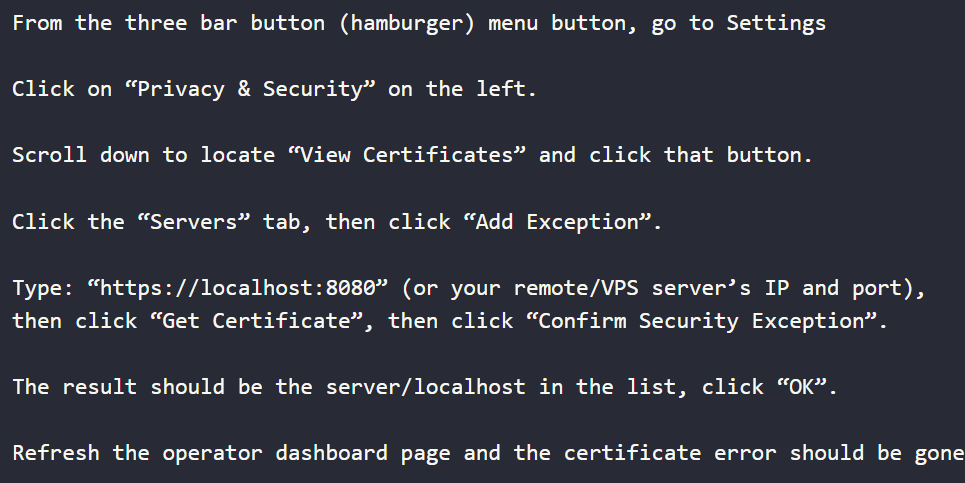
You will be asked for your password set during setup.
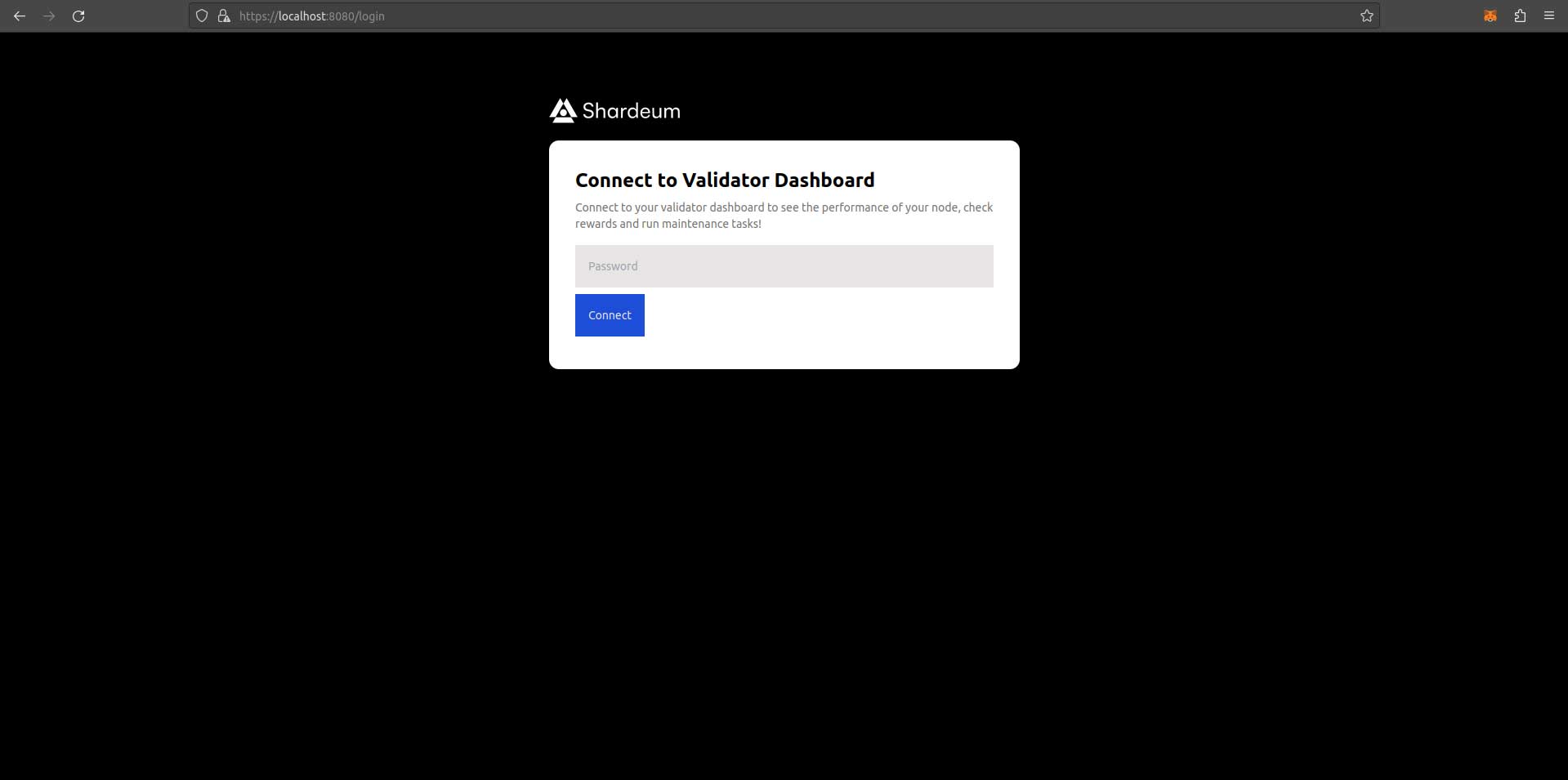
DANGER
The login will fail even if you put no password during the setup process. To set a new password inside the validator CLI:
- Comand 2 -
operator-cli gui set password <type_new_password__here>
You should see the “Overview” page for the Shardeum Validator Dashboard in your web browser:
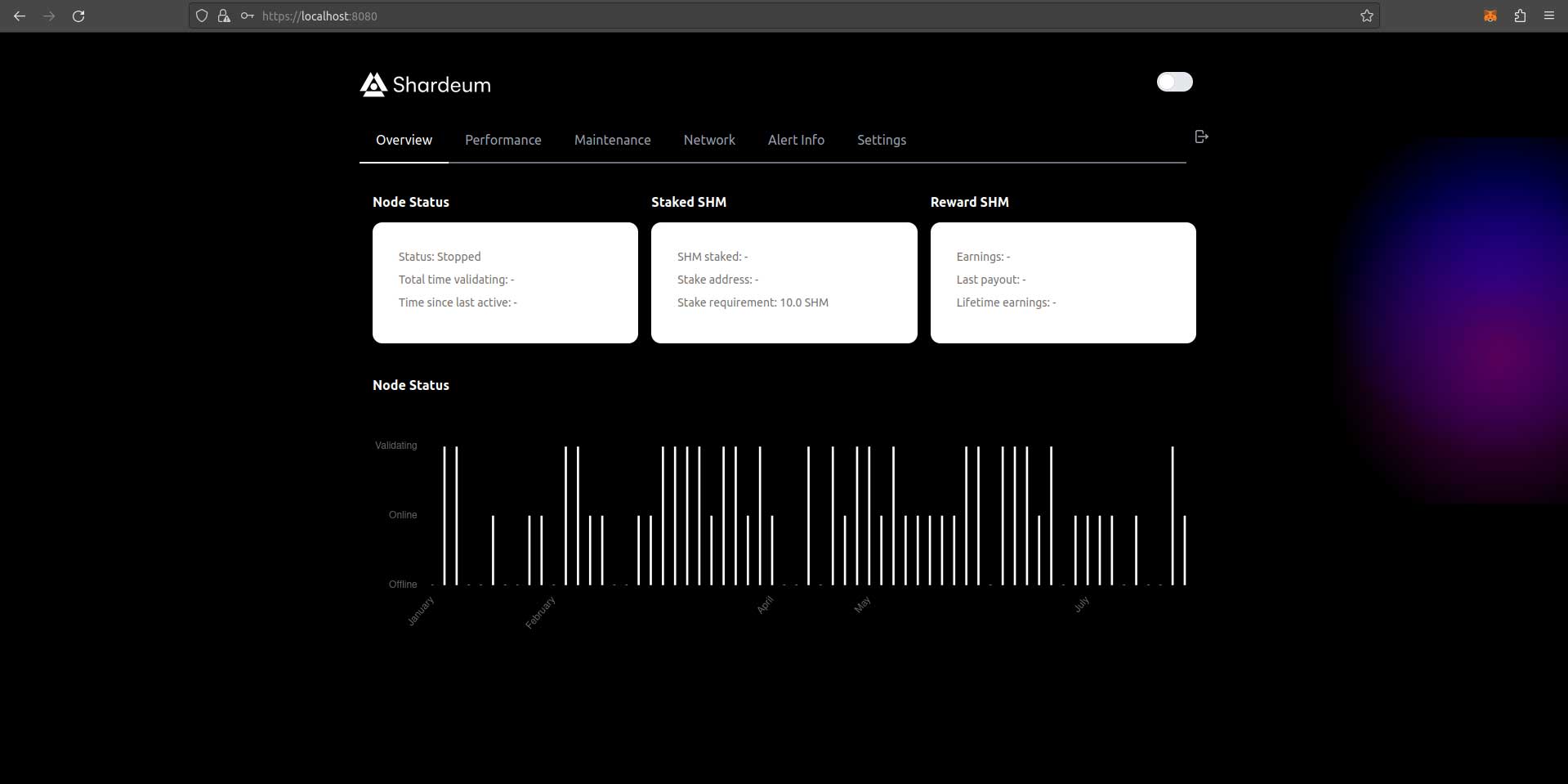
Step 5: Start validator
Go to the “Maintenance” page, then click the “Start Node” button in the top left white box:
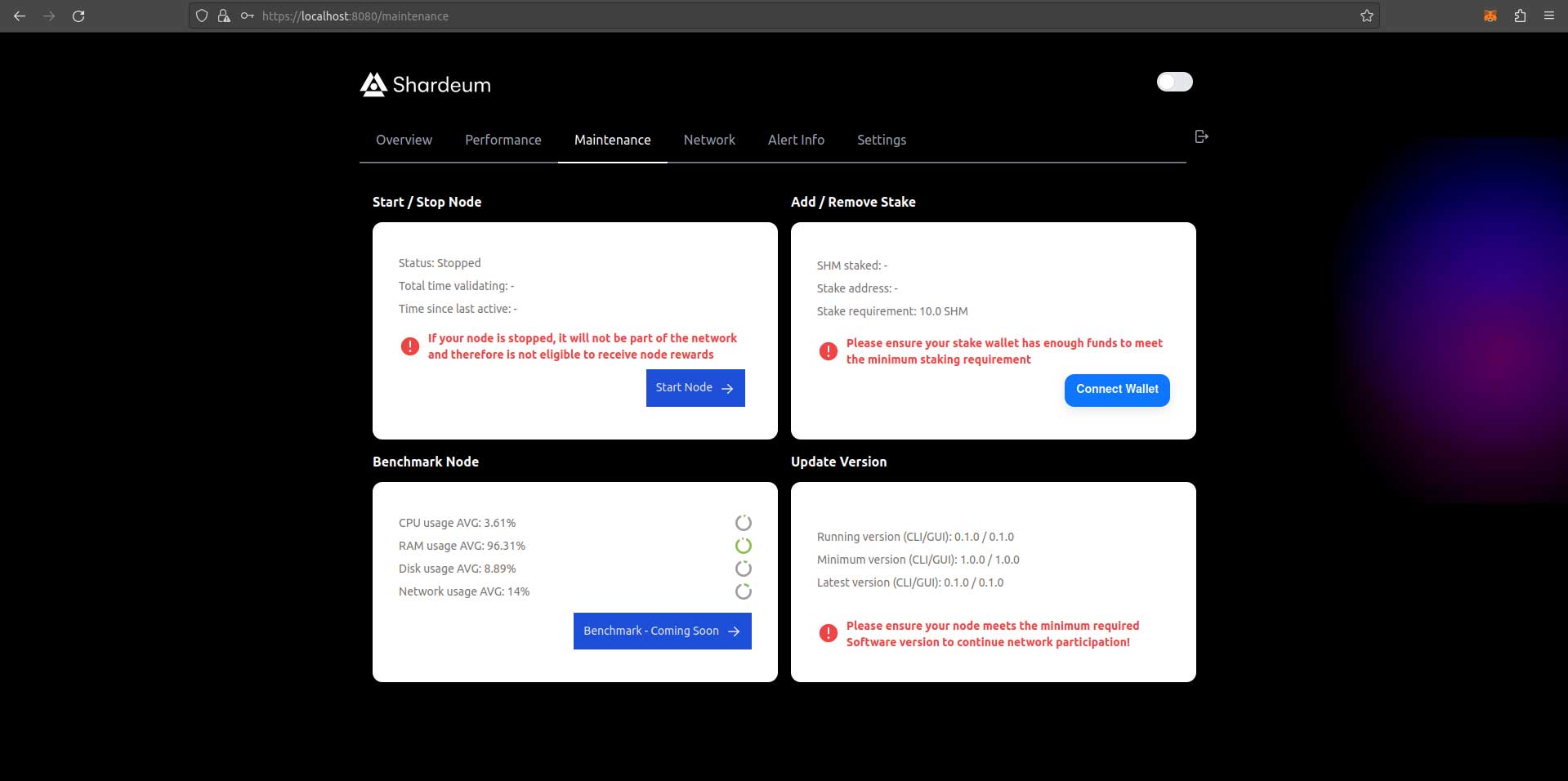
Comand - 1 operator-cli start
Wait and refresh the page.
The node is running correctly if the “Start Node” button now says “Stop Node”. If you want to stop tne node with the CLI:
Comand - 2 operator-cli stop
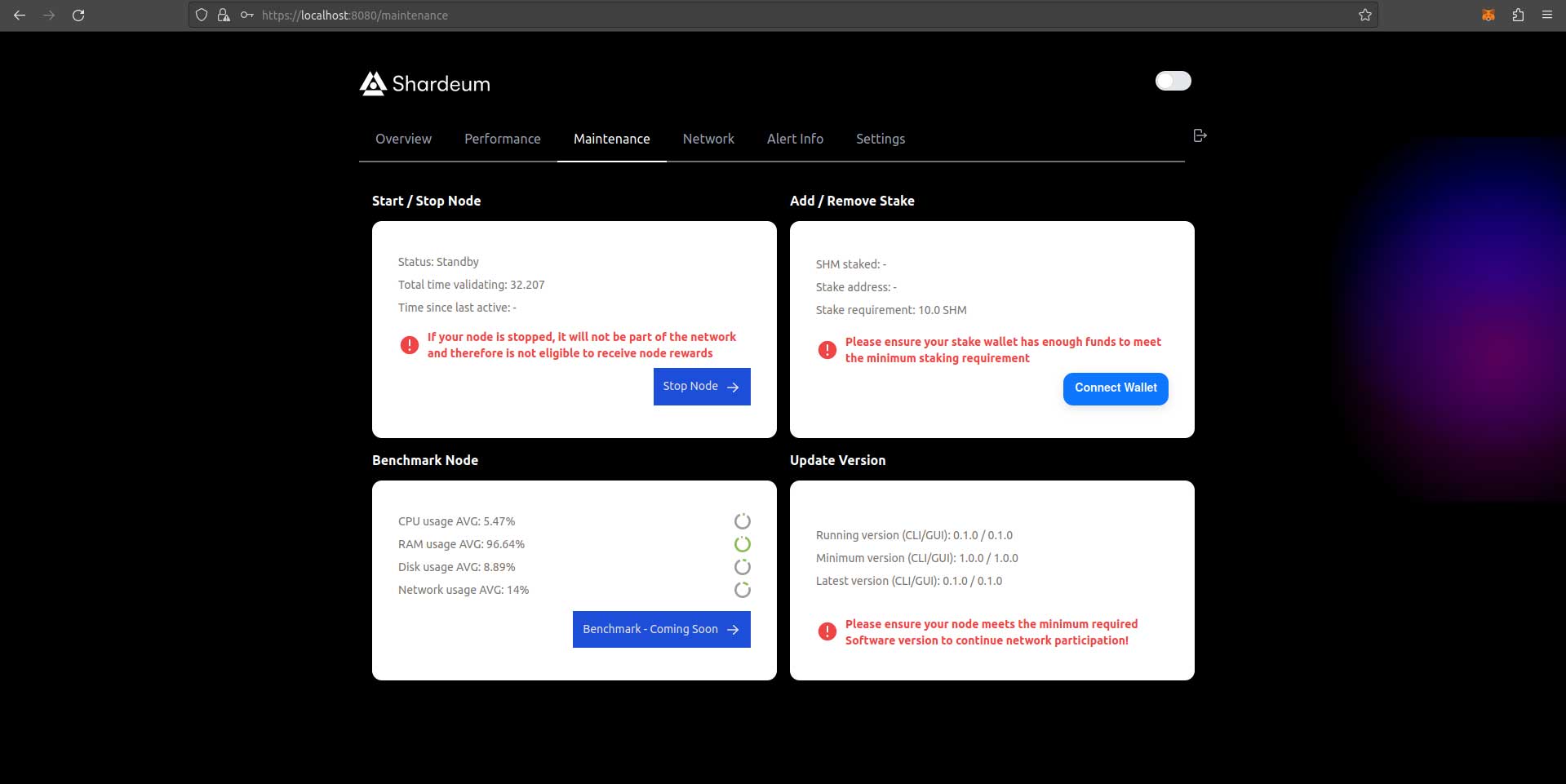
Step 6: Monitor validator
Go to “Performance” to see your node’s hardware performance here:
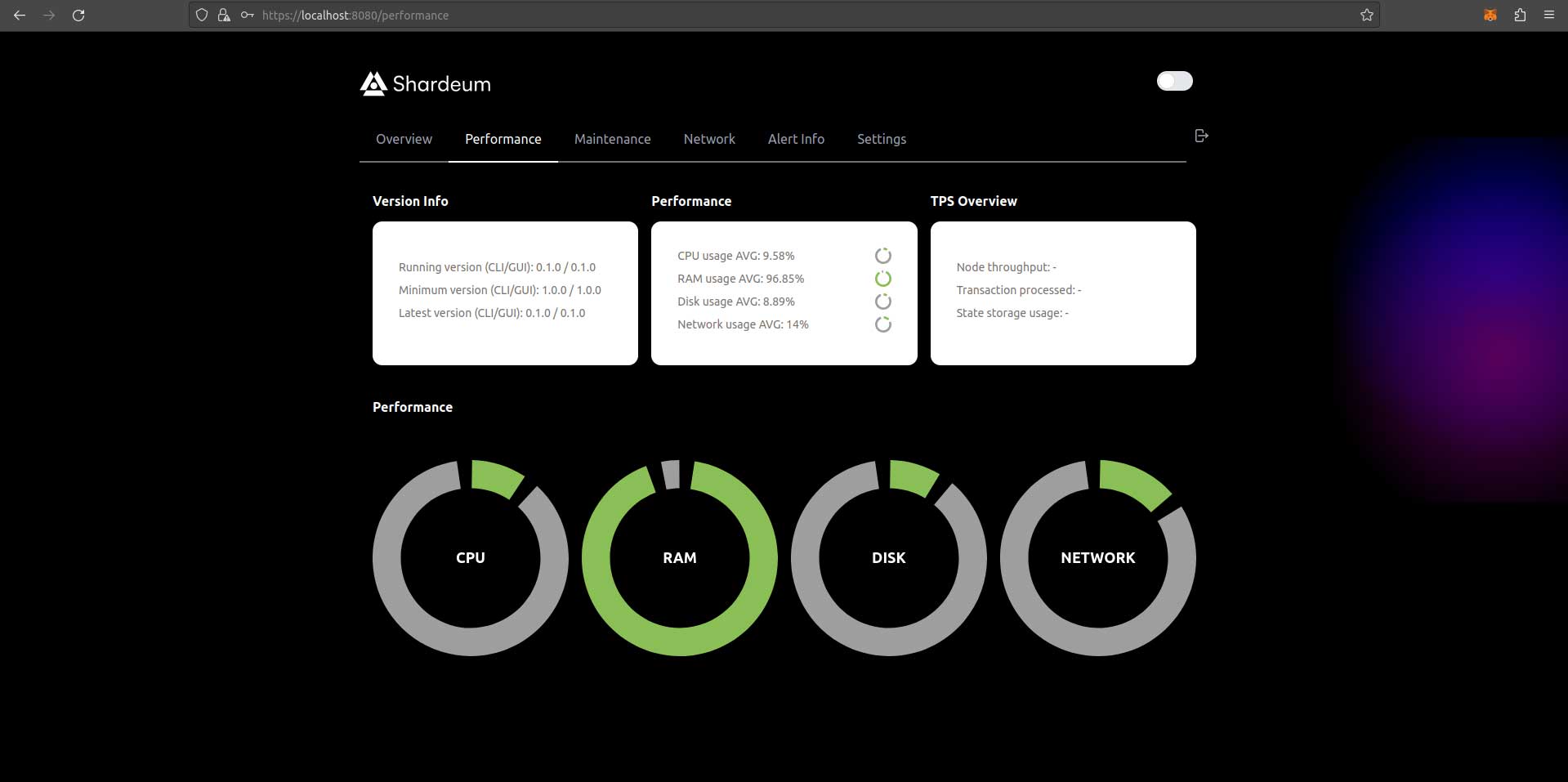
For more details about your node status run the following inside the CLI:
Run Comand - operator-cli status
DANGER
If your node becomes inactive, try checking its status.
Run Comand - pm2 list
Reset the validator from the list by running:
Run Comand - pm2 delete [id]
Step 7: Connect Wallet to Betanet
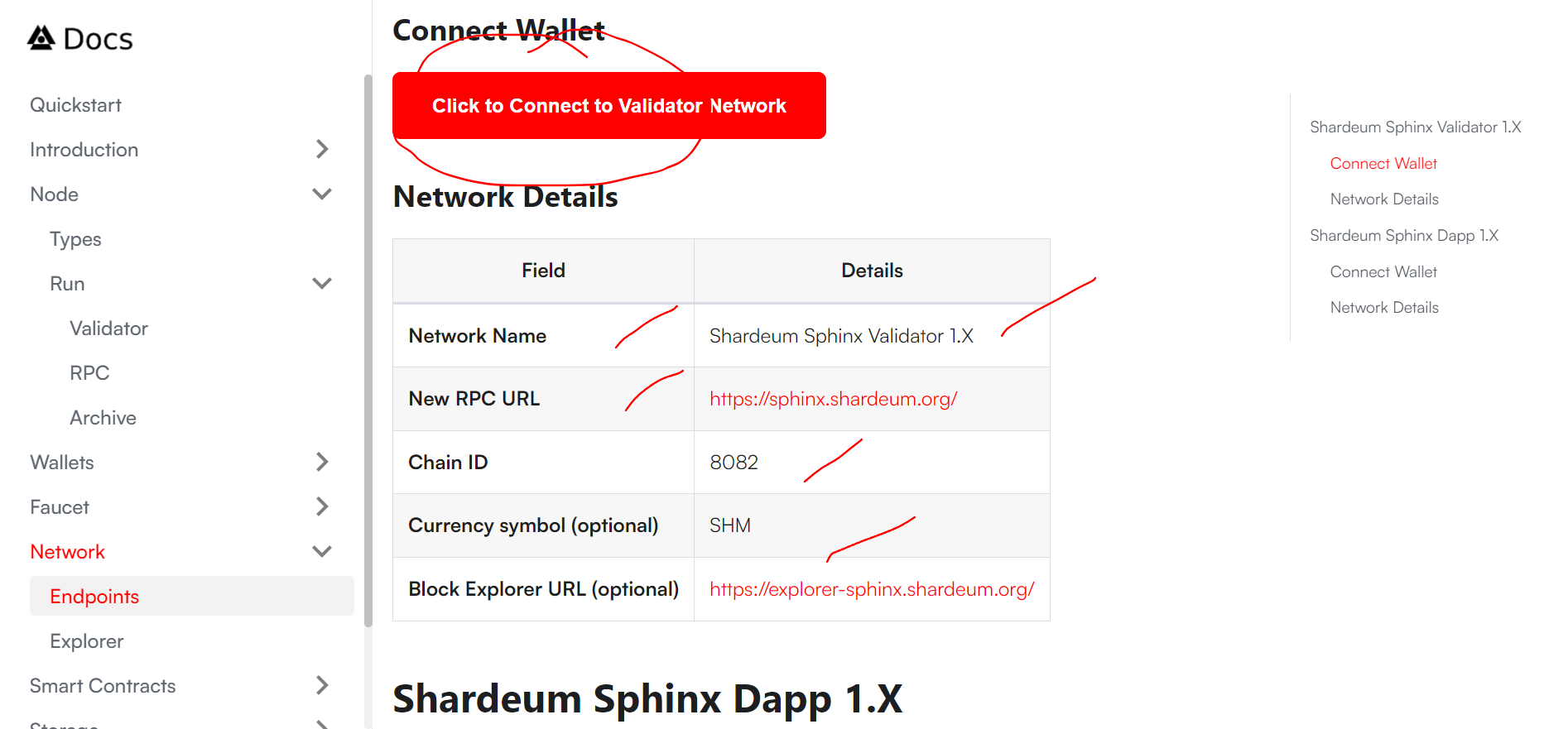
Step 8: Get SHM from Betanet Faucet
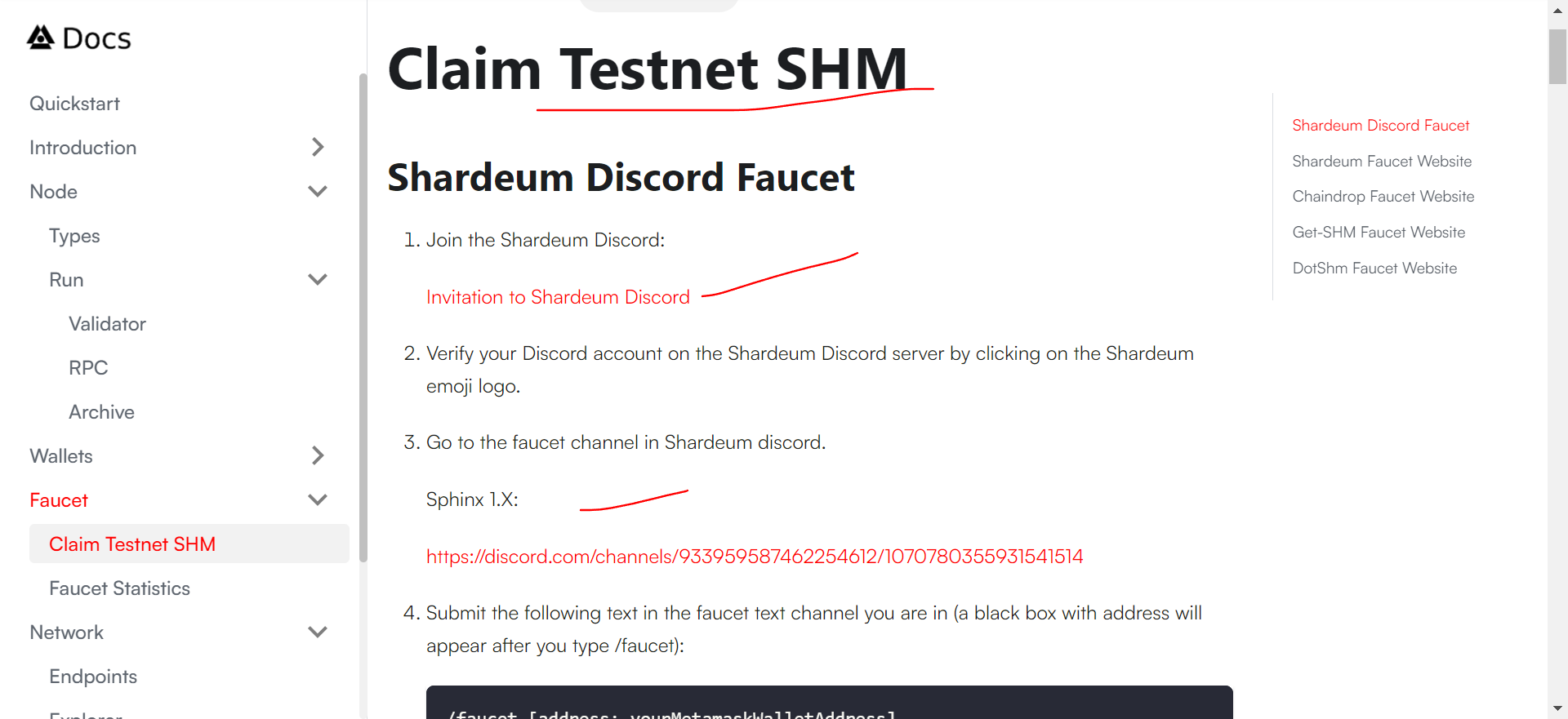
Step 9: Stake SHM to validator
GUI
After you start the validator, go to the “Settings” page. You will be asked to connect your wallet:
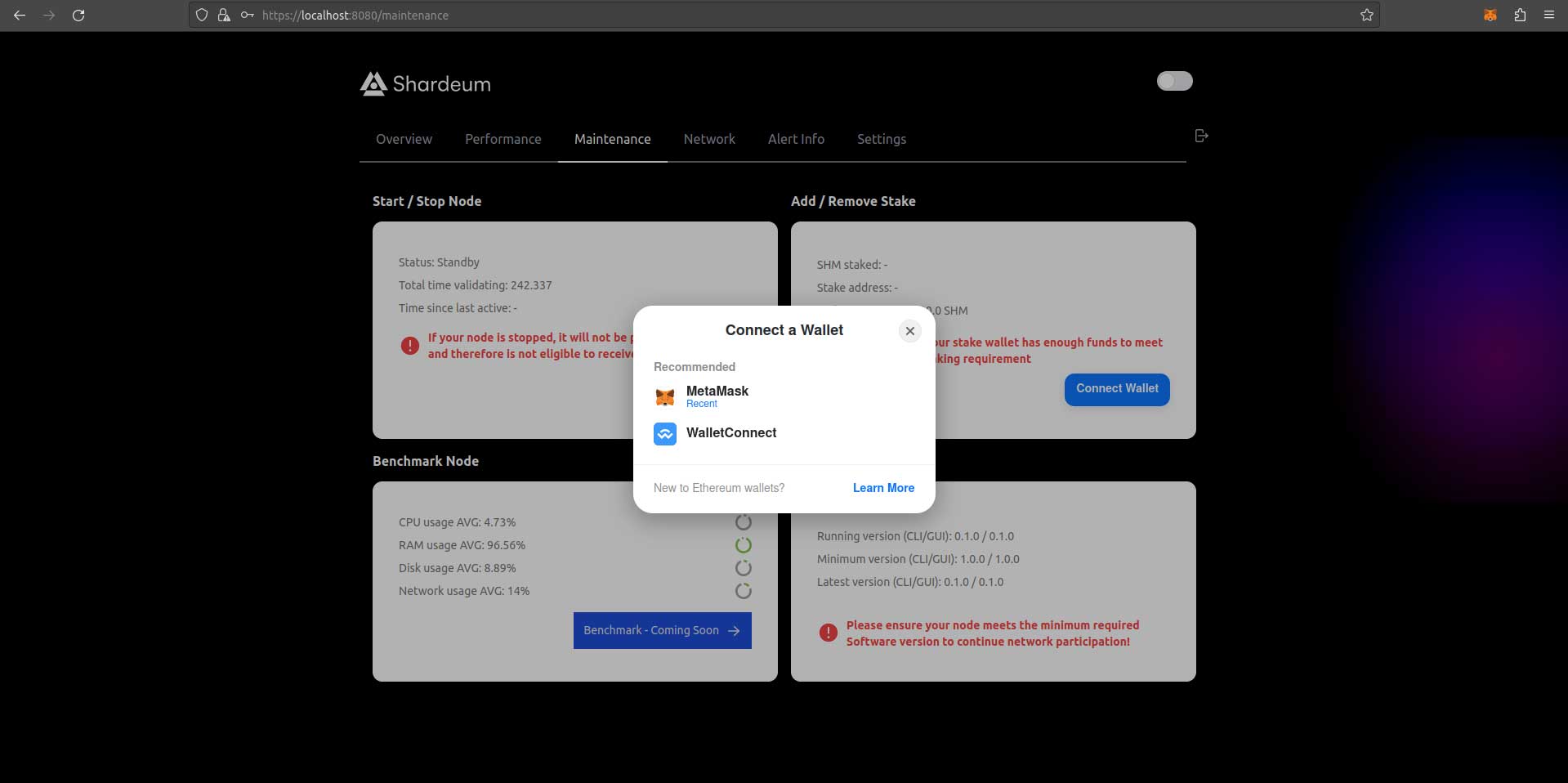
After you connect your wallet, you should see the following:
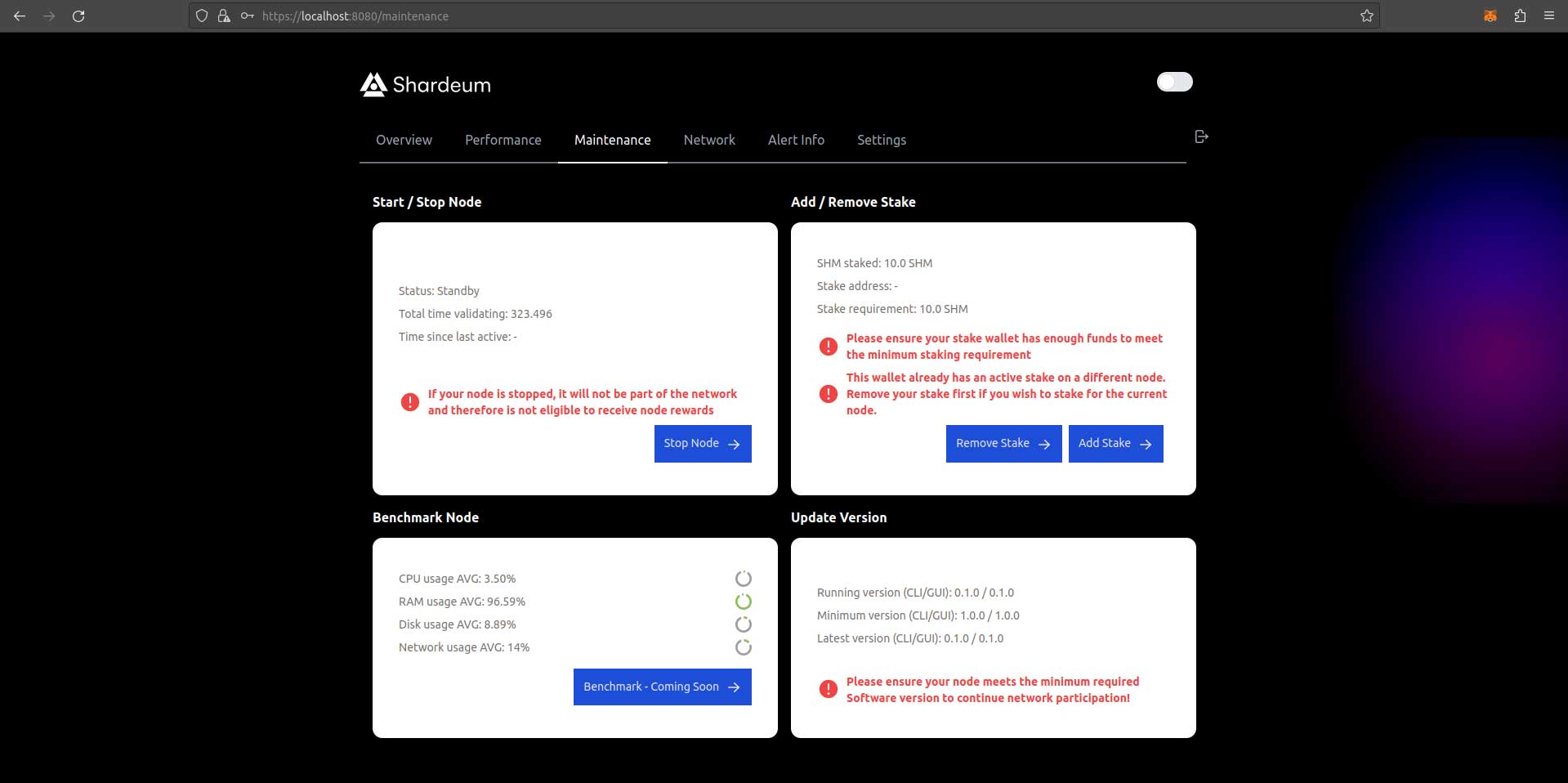
When you click "Add Stake", you will see the following:
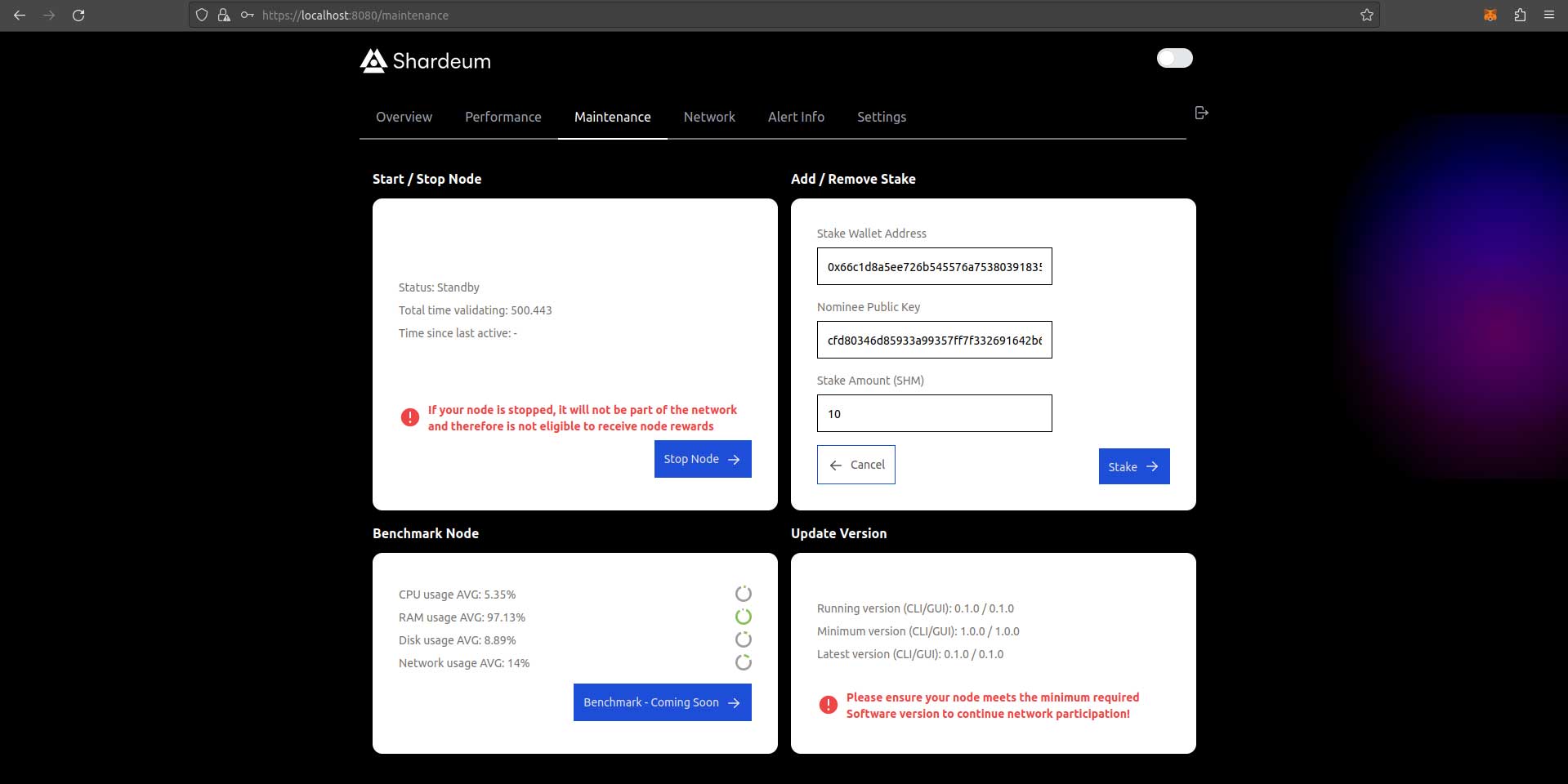
Run Comand - -Stake Wallet Address [wallet connected] -Nominee Public Key [filled in automatically while validator is running] -Stake amount (SHM) [empty and is in units ether not wei]
This example has filled in 10 SHM tokens to stake.
TIP
It is recommended to stake just 10 SHM per Validator node, since rewards will be the same with 10 SHM or more staked for a Validator.
Once all fields are filled, click the “Stake” button.
Your wallet will ask you to sign the transaction stake your SHM.
Once the transaction is signed and complete, you have staked your SHM tokens successfully.
INFO
If your node status is on Standby and you have 10 SHM or more staked, your validator node is setup correctly.
The network will automatically add your validator to be active in the network.
The time to be added as an active validator will vary based on network load and validators in the network.
CAUTION
If you have staked before, you can "Remove Stake". However, you will stop getting testnet SHM rewards when you unstake.
DANGER
If you see your validator IP address as "0.0.0.0":
Go into the operator dashboard docker (may be different if you customized install location:
- Run Comand -
cd ~/.shardeum ./shell.sh
**Get your node's external IP:
- Run Comand - curl https://ipinfo.io/ip
The returned IP in the format of nnn.nnn.nnn.nnn is your EXTERNAL_IP.
Set the number above in place of EXTERNAL_IP:
Run Comand - export APP_IP="EXTERNAL_IP"
- CLI
You can also stake and unstake from the Validator CLI if you are not able to access a web browser for the Validator GUI.
First, set your private key in your Validator CLI:
WARNING
Be very careful with your private keys. We recommend you use a private key which has testnet tokens only to be safe.
Run Comand - export PRIV_KEY=<private_key>
Make sure your private key is stored in your Validator CLI by running:
Run Comand - echo $PRIV_KEY
Add stake with:
Run Comand - operator-cli stake 10
Check your stake amount with:
Run Comand - operator-cli stake_info <wallet_address>
Remove stake with:
Run Comand - operator-cli unstake
Validator
WARNING
New validator versions will be released over time. It is necessary to keep your validator updated by checking the minimum version required and your current version periodically.
Run Comand - curl localhost:9001/nodeinfo
Update
-
Stop your validator before updating (you don't need to unstake though)
-
In your terminal, first exit from the container using
-
Comand -
exit cd .. -
Run the following curl script -
curl -O https://gitlab.com/shardeum/validator/dashboard/-/raw/main/installer.sh && chmod +x installer.sh && ./installer.sh
CAUTION
You might manually have to start the GUI afterwards with:
Run - operator-cli gui start
Check your currect version from either CLI or GUI and make sure it is the latest version.
Exit Error Logs
Run Comand - sudo docker exec shardeum-dashboard cat cli/build/logs/exit-summary.json
CLI And GUI
Run Comand - operator-cli version
Update
Run Comand - operator-cli update
Commands - To see all CLI commands, run:
Run - operator-cli help
Uninstall Validator
Useful if your validator is outdated and you want to clean your last installation.
You can delete the validator folder while in your root directory with:
Run Comand - rm -rf .shardeum
You can also delete docker containers and images that the Shardeum validator was using.
DANGER
These commands will delete all docker images and containers on your computer!
Delete all docker containers:
Run Comand - docker rm -vf $(docker ps -aq)
Delete all docker images:
Run Comand - docker rmi -f $(docker images -aq)
Thats all my brother and sister
✅ That's all for now Bro so show your Genuine Support for my Motivation 💟
✨ Subscribe and Collect this NFT for showing your support to our team! More collects, more guides ✨
🌐 Our social media: 🟢 Twitter | Telegram | Lens 🟢